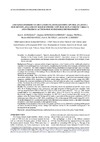Identificador persistente para citar o vincular este elemento:
https://accedacris.ulpgc.es/jspui/handle/10553/74506
| Título: | Artisanal fisheries in the canary islands (Eastern-central atlantic): Description, analysis of their economic contribution, current threats, and strategic actions for sustainable development | Autores/as: | González, José A. González-Lorenzo, Gustavo Tejera, Gonzalo Arenas-Ruiz, Rocío Pajuelo, José G. Lorenzo, Jose M |
Clasificación UNESCO: | 510208 Pesca 5312 Economía sectorial |
Palabras clave: | Action Plan Artisanal Fishing Techniques Canary Islands Economic Value Seafood Products |
Fecha de publicación: | 2020 | Proyectos: | Desenvolvimiento de condiciones técnico científicas, formación transferencia de tecnología y conocimiento Valorización de productos marinos de la Macaronesia: Turismo, gastronomía y capacitación profesional |
Publicación seriada: | Acta Ichthyologica et Piscatoria | Resumen: | Fishing is a primary activity of great importance in the Canaries and has traditionally played an important role in reducing poverty, in job creation, strengthening food security and sovereignty, and increasing the value of its products. This study is needed to analyze fishing contribution in a region strongly based on tourism. Aims were: to update the inventory of fishing techniques, to detail the biodiversity involved, and for the first time to analyze the contribution of the landings. We also identify threats to the activity and draft a plan with strategic actions for its sustainability. Materials and methods. Data on the fisheries and the 2007–2018 series of landings were taken from the regional government website. Once the database was refined, data were analyzed in main four environmental resource categories: shellfish (SHS), demersal fish (DMF), coastal pelagic fish (CPF), and oceanic pelagic fish (OPF). To analyze the economic contribution of the fisheries, first-sale reference prices were compiled from fisheries entities. To estimate the contribution of this sector to the regional GDP, its economic value was compared with the mean value of GDP for 2014–2018 GDP. Results. The versatility is the main characteristic of the fleet, which was stabilized around 600 vessels within 2016–2018. Fishing techniques vary enormously, and eight categories of fishing gear were identified. Total landings ranged between 5560 t in 2007 and 15 466 t in 2016, with a mean value of 11 254 t · y–1. SHS reached a mean value of 111 t, representing only 1%, DMF 1683 t (16%), CPF 1926 t (17%), and OPF 7533 t (65%). Biodiversity targeted by these fisheries throughout the 2007–2018 period involved about 200 species. As a primary sector, the Canary Islands’ fishing activity made a mean value of the economic contribution of €73.19 million per year at first-sale in 2007–2018, contributing 0.19% of the regional GDP overall during 2014–2018. When the fishing activity is considered together with other local socio-economic sectors in the added-value chain of seafood, it contributes acceptably to the regional economy. Conclusion. Overexploitation of fish stocks is the greatest problem to solve, followed by poaching and the growth of intense recreational fishing. Ad-hoc strategic and structured actions for the sustainable development of the fishing activity are proposed. | URI: | https://accedacris.ulpgc.es/handle/10553/74506 | ISSN: | 0137-1592 | DOI: | 10.3750/AIEP/02963 | Fuente: | Acta Ichthyologica et Piscatoria [ISSN 0137-1592], v. 50 (3), p. 269-289, (Enero 2020) |
| Colección: | Artículos |
Citas SCOPUSTM
18
actualizado el 08-jun-2025
Citas de WEB OF SCIENCETM
Citations
21
actualizado el 08-jun-2025
Visitas
841
actualizado el 06-dic-2025
Descargas
622
actualizado el 06-dic-2025
Google ScholarTM
Verifica
Altmetric
Comparte
Exporta metadatos
Los elementos en ULPGC accedaCRIS están protegidos por derechos de autor con todos los derechos reservados, a menos que se indique lo contrario.
